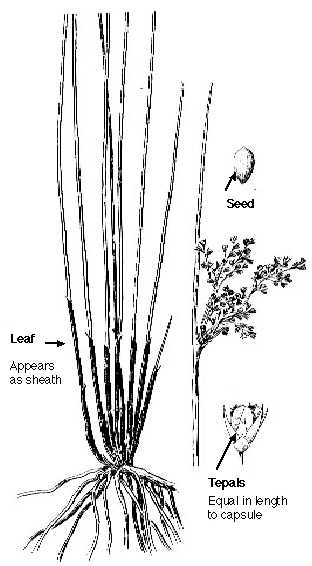
General Species Description
- Soft rush is a perennial, native, emergent plant growing to a height of 20-100 cm. This species has stout rhizomes and grows in distinct tufts. Soft rush appears to be leafless (leaves are reduced to sheaths that surround stem bases) and have lateral inflorescences (involucral bract appears to be a continuation of the stem). Soft rush is the most tufted rush in the Pacific Northwest.
Leaves
- Soft rush has no apparent leaf blades. The leaves are basal and reduced to brown sheaths wrap around the stems.
Inflorescence/Flowers
- Soft rush appears to have lateral inflorescences because the involucral bract, which is round and erect, appears to be a continuation of the stem. The inflorescence is a diffuse to tight panicle, between 3-15 cm in length. Individual flowers have "scales" or tepals (sepals and petals) which are greenish or brown, needle-like, and approximately equal in length with the capsule (2-3.5 mm). This species usually has 3 stamens. Blooms June through August.
Fruits
- The capsules are oval, blunt or rounded at the tip and distinctly 3-cornered. The seeds are elliptical, finely ridged and minutely pointed at the tip.
Habitat
- Soft rush is often found in wet fields, pastures, ditches, tidal flats (fresh and salt water), also in shallow water at edges of ponds or lakes. Soft rush can be found in association with tufted hairgrass (Deschampsia cespitosa), three-square bulrush (Scirpus americanus), Baltic rush (Juncus balticus) and creeping buttercup (Ranunculus repens).